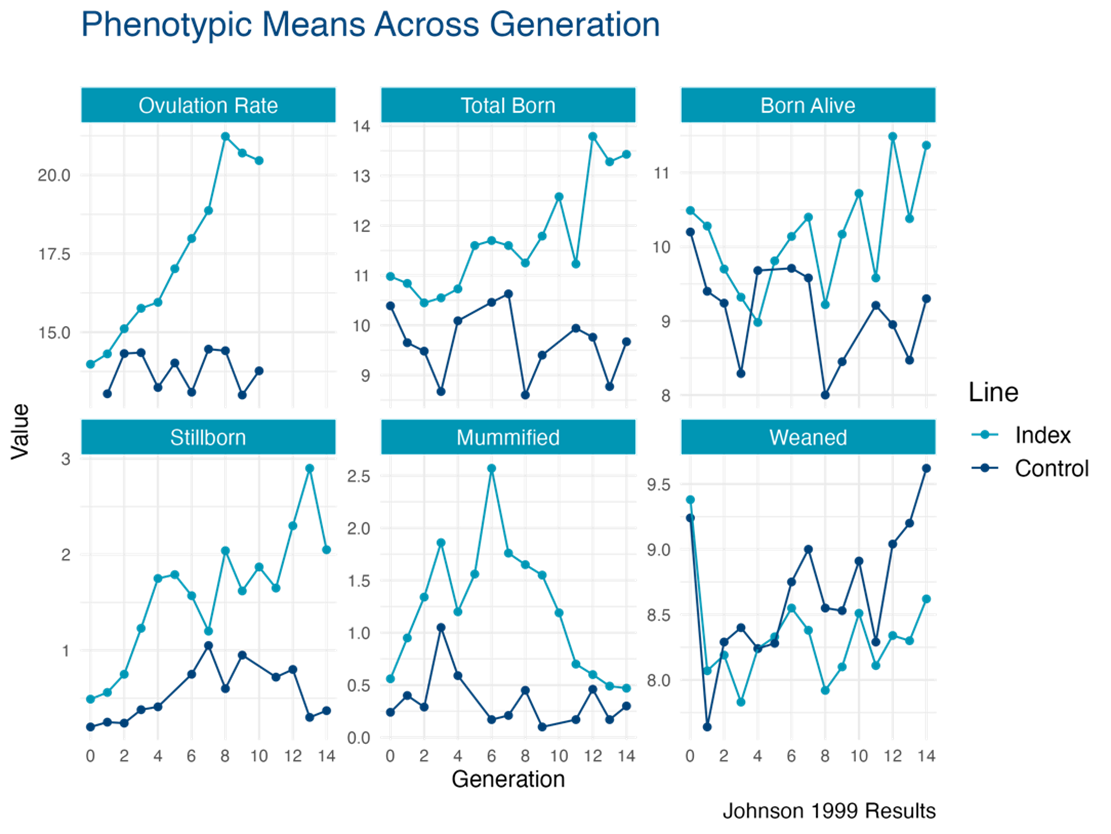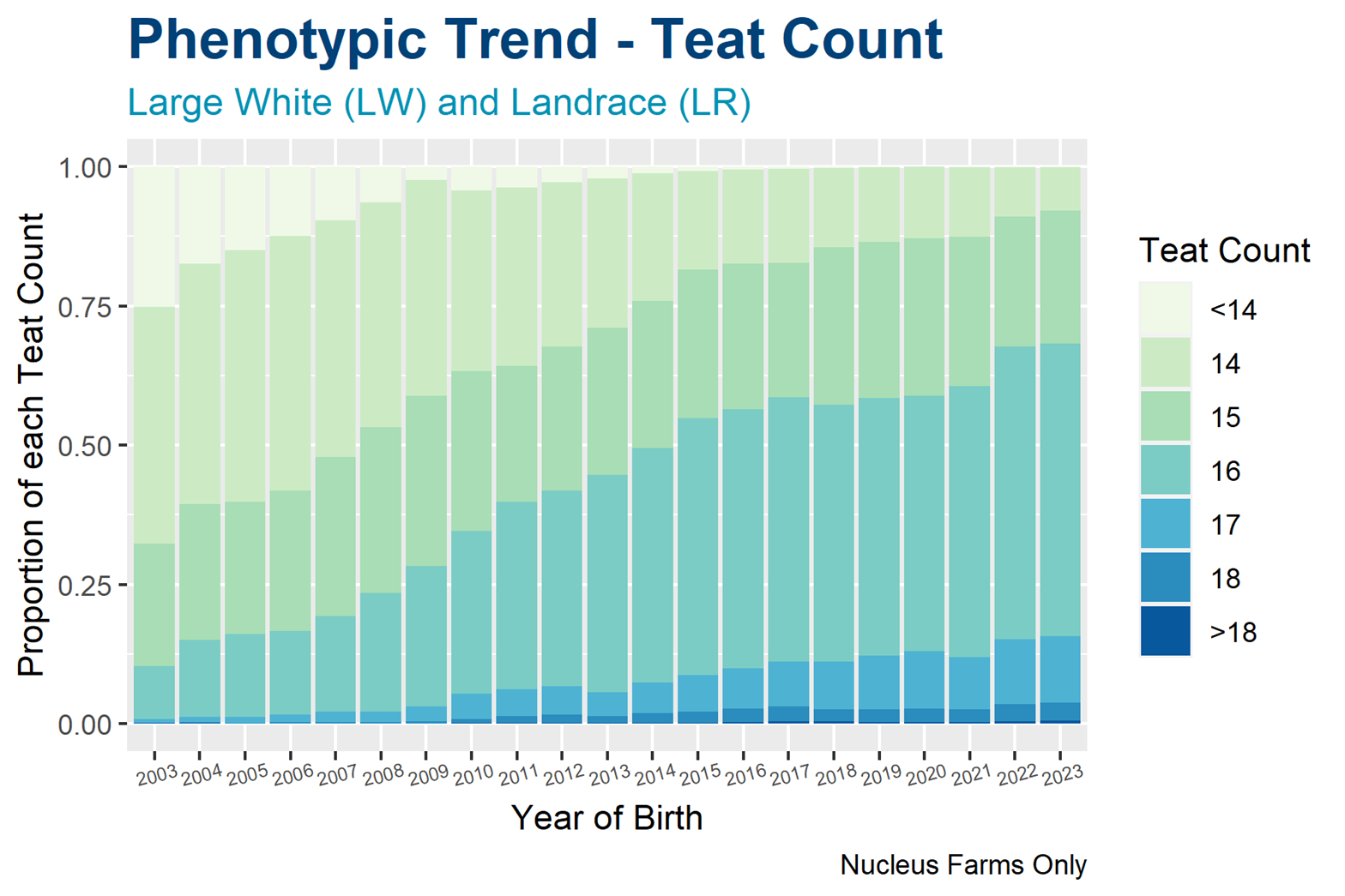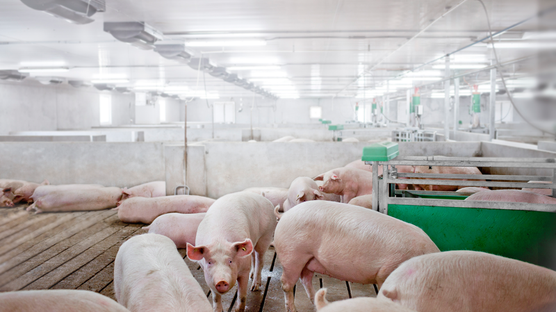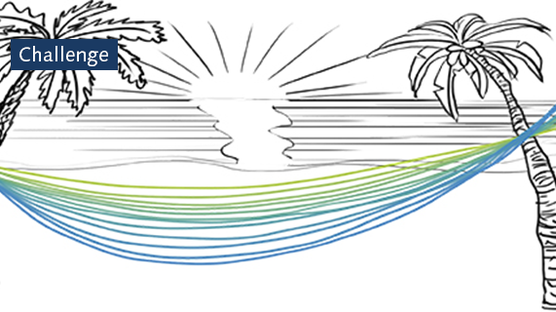
Published on Dec. 19, 2023
Strategies in Breeding: Balancing Litter Size with Preweaning Survival
Hypor is committed to balanced breeding. For example, by focusing on preweaning survival more than initial litter size, this has a direct impact on animal welfare as well as economic returns for the producer.
Animal breeding literature supports this decision, from historical selection experiments illustrating that increases in total born do not necessarily increase the number weaned. Hypor also improves piglet quality through the increase in piglet birth weight, reduction in birth weight variation, and reduction in runt piglets.
Introduction
Litter size is an important part of the maternal objective of pig breeding companies. Pigs weaned/mated female/year (PSY) is the main KPI that defines maternal efficiency for sow farms. Unfortunately, PSY is not a measurable trait on individuals. The main decision for breeding companies is deciding which trait(s) should be used to increase maternal efficiency.
In the very early days (~1970’s), it was questioned if selection for litter size was possible due to the very low heritability of these traits1. Keep in mind this was prior to the powerful BLUP statistical methodology and genomic selection we utilize today. Most litter size traits have a heritability below 0.15, indicating that less than 15% of the variation we observe is due to genetics. To test if litter size would respond to selection, an experiment was designed and carried out at the University of Nebraska–Lincoln (UNL) by Dr. Rodger Johnson. Dr. Johnson initially set up a line with the goal of indirectly increasing total born, through an index of ovulation rate and embryonic survival (later switching to total born directly). Figure 1 shows the results of this experiment2. The selection program was successful at increasing ovulation rate along with total born, followed by the number born alive (NBA). However, there were unintended consequences that led to a higher number of stillbirths, mummified piglets, and pre-weaning mortality (PWM). This ultimately led to the selected line and the control line weaning a similar number of piglets per litter year over year.

In real breeding programs, similar outcomes were observed. With total born per litter as the sole objective, there was an increase in stillbirths and pre-weaning mortality, leading to little or no increase in piglets weaned3. Due to Johnson’s results along with evidence from active breeding programs, many maternal selection objectives shifted in the early 2000’s away from total born as the sole objective.
Hsu and Johnson4 later presented the complete results from this long-term selection experiment at UNL for litter size. Their research reported the genetic correlation between total born and number weaned between -0.53 and 0.04 (3 estimates). Genetic correlations can be interpreted as the correlation between breeding (genetic) values, helping us understand how selection on one trait may drive other trait means over time. A negative or zero correlation between the total number of piglets born and the number of weaned piglets indicates that, at best, there will be no change in the number of piglets weaned with selection based on the total number of piglets born. At worst, the number of weaned could be reduced by selecting on total born by itself. Other estimates have shown low to moderate positive genetic correlations, but they are still far from one5. Differences in estimates may be highly influenced by cross-fostering strategies, which are often not reported in literature and not well recorded on farm.
Balanced selection practices
Due to the lack of evidence that increasing initial litter size (total born or born alive) will increase the number of weaned piglets, Hypor decided to utilize three separate traits to increase weaned numbers. Starting in the early 2000’s Hypor chose 1) total born, 2) percent born alive, and 3) percent weaned all on a litter basis (Figure 2). Total born is simply the count of pigs born at birth (dead + alive). Percent born alive is the ratio of born alive to total born (expressed as a percentage), often referred to as farrowing survival. Percent weaned is the ratio of the number of weaned pigs divided by the sum of those born alive and fostered onto (or off of) the litter (expressed as a percentage), often referred to as preweaning survival in production.

The perceived downside of this strategy is that genetic improvement on initial litter size has been slower than direct selection on total born or born alive6. This is due to the antagonistic (unfavorable) genetic relationship between initial litter size and piglet survival. Therefore, to make more progress in number weaned, Hypor chose to improve all three traits simultaneously and more gradually, versus making progress in one trait quickly at the detriment of other important traits. Without balanced selection, overall maternal efficiency would have changed much slower.
What about piglet quality?
We cannot discuss litter size without a discussion on piglet quality. The prevailing thought is that as litter size increased, piglet quality deteriorated and directly caused the reduced survivability of piglets. As a result, many producers have shifted their focus to individual birth weights of piglets. Selection for litter size over the years has reduced the size of piglets at birth in many genetic lines. So why not put a lot of pressure on birth weights in place of selection for piglet survival? For many years, the strong phenotypic relationship between individual birth weight and piglet survival has been well established, with emphasis on the phenotypic.
This is true, we know from data that small piglets will be at a disadvantage to compete and therefore, more likely to die in farrowing. This however ignores the fundamental fact that ‘small’ and ‘large’ are relative terms. Selection for individual birth weights would shift the entire distribution a small amount, say by adding 50 g (~0.1 lb) to every piglet born. Yet the issue of competition in very large litters remains. Smaller piglets, no matter their absolute weight, will be at a major disadvantage relative to heavier litter mates. This is an explanation as to why we see similar survival curves with any age of pig (e.g. weaning weights into nursery). The absolute value is much higher, yet we often still observe low weaning weight pigs perform worse in wean-to-finish compared to heavier contemporaries. The main problem is researchers and producers alike interpreting the well-known phenotypic correlation as a genetic correlation (i.e. correlation of breeding values)7. Some genetic correlations have shown to be as low as 0.14 between birth weight and piglet survival8.
This concept was first articulated 40 years ago by English and Morrison9.
“Attempts to improve piglet survival by achieving slight improvements in mean piglet birth weight are likely to prove disappointing since variation in piglet birth weight within litters has a much greater influence on piglet mortality than mean piglet birth weight per se. Variation in birth weight within litters certainly does not decrease as mean birth weight is improved and so the problem of smaller piglets competing within litters with larger littermates for sucking positions and for nutrition remains. It is this very competitive situation which prevails within litters for nutrition which puts the smaller piglet at such a distinct disadvantage relative to its larger littermate.”
Although PWM and birth weight are not strongly associated genetically, there is still a low genetic correlation between birth weight and survival. Birth weight is also genetically associated with other important traits such as weaning weight and later growth rate. As mentioned above, variation in birth weight is more strongly associated genetically with piglet survival. Therefore, Hypor's breeding program includes both mean and variation in birth weight traits along with a runt piglet trait (< 800 g) in the maternal objective as auxiliary traits to the primary traits of total born and piglet survival. Our goal is to increase individual birth weight, reduce variation in birth weight, and reduce the number of runt piglets.
Producers may be tempted to increase average piglet birth weight through management interventions, mimicking selection for mean birth weight. However, to our knowledge, no large reductions in PWM have been observed with an intervention such as bump feeding late in gestation. Several studies have shown bump feeding will only increase birth weight in first parity sows. This is analogous to the low genetic correlation between these traits, adding a small amount to every piglet does little to eliminate the problem of competition from larger litter mates. Producers would be better off focusing their time, money, and energy on other factors known to reduce PWM directly. These include reducing drafts and altering ventilation, checking heat lamps/mats, and CaCl before farrowing, and more frequent feedings to reduce stillborns10.
Teat Count
Finally, we cannot avoid discussing another limiting factor in weaning pigs, teat counts. Hypor has put considerable pressure on functional teat counts for many years (Figure 3). Gilts need to start with enough teats as we know sows lose functional teats as they age and throughout a lactation11. Wiegert and Knauer12 have shown that piglet survival can be as low as 75% for sows with 14 or fewer teats, while sows with 17 teats can on average wean 90% of their piglets.

Genetics or management?
Feedback from producers indicate that many of them attribute initial litter size (e.g. total born) to their genetic supplier along with birth weight, while PWM is viewed as something that can be changed with management. While there are many interventions producers can implement to improve both total born and PWM, both are under considerable genetic control and therefore can be selected in a balanced breeding program. Although heritability estimates are low (often below 0.15), genetic progress is cumulative and should be in the economically desired direction (i.e. weaned pigs).
In conclusion
The economic value for total born or live born piglets is $0. Only weaned pigs should have an economic value in combination with wean-to-finish traits. For producers to wean more pigs, their genetic supplier must put enough emphasis on piglet survival traits directly and not indirectly through either selection for initial litter size or individual piglet birth weight. Hypor has been directly selecting for piglet survival for many years to increase the number of pigs weaned. Not only is this important for the health of the piglets we care for, it also has a direct impact on the sustainability of the entire industry.
References
1 Haley, C. S., E. Avalos, and C. Smith. 1988. Selection for litter size in the pig. Animal Breeding Abstracts. 56:5:317-332.
2 Johnson, R. K., M. K. Nielsen, D. S. Casey. 1999. Responses in ovulation rate, embryonal survival, and litter traits in swine to 14 generations of selection to increase litter size. Journal of Animal Science. 77:541-557.
3 Nielsen, B., G. Su, M. S. Lund, and P. Madsen. 2013. Selection for increased number of piglets at d 5 after farrowing has increased litter size and reduced piglet mortality. Journal of Animal Science. 91:2575-2582.
4 Hsu, W. L., and R. K. Johnson. 2014. Analysis of 28 generations of selection for reproduction, growth, and carcass traits in swine. Journal of Animal Science. 92:4806-4822.
5 Su, G., M. S. Lund, and D. Sorensen. 2007. Selection for litter size at day five to improve litter size at weaning and piglet survival rate. Journal of Animal Science. 85:1385-1392.
6 Knap, P. W., E. F. Knol, A. Christian Sorensen, A. E. Huisman, D. van der Spek, L. J. Zak, A. G. Chapatte, and C. R. G. Lewis. 2023. Genetic and phenotypic time trends of litter size, piglet mortality, and birth weight in pigs. Frontiers in Animal Science. 4:1218175.
7 Knol, E. F., J. I. Leenhouwers, T. van der Lende. 2002. Genetic aspects of piglet survival. Livestock Production Science. 78:47-55.
8 Putz, A. M., F. Tiezzi, C. Maltecca, K. A. Gray, and M. T. Knauer. Variance component estimates for alternative litter size traits in swine. Journal of Animal Science. 93:5153-5163.
9 English, P. R., and V. Morrison. 1984. Causes and prevention of piglet mortality. Pig News and Information. 5:4:369-376.
10 Knauer, M. T. 2022. Feeding strategies to reduce farrowing duration, boost piglet survival. National Hog Farmer. https://www.nationalhogfarmer.com/farrowing/feeding-strategies-to-reduce-farrowing-duration-boost-piglet-survival
11 Fix, J., T. See. 2009. Functional underline sections affect pig weight at weaning. The Pig Site. https://www.thepigsite.com/articles/functional-underline-sections-affect-pig-weight-at-weaning
12 Wiegert, J., A. Earnhardt, M. T. Knauer. 2018. Sow functional teat number impacts piglet performance. National Hog Farmer. https://www.nationalhogfarmer.com/hog-reproduction/sow-functional-teat-number-impacts-piglet-performance



